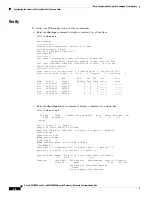
Basic Configuration Using the Command-Line Interface
Configuring ISDN PRI
13
Cisco AS5350XM and Cisco AS5400XM Universal Gateways Software Configuration Guide
For a complete description of the commands mentioned in this section, refer to the
Cisco IOS Dial
Technologies Command Reference
for your software release.
Request PRI Line and Switch Configuration from a Telco Service Provider
Before configuring ISDN PRI on your Cisco router, you need to order a correctly provisioned ISDN PRI
line from your telecommunications service provider.
This process varies from provider to provider on a national and international basis. However, some
general guidelines follow:
•
Determine if the outgoing B channel calls are made in ascending or descending order. The Cisco IOS
software default is descending order; however, if the switch from the service providers is configured
for outgoing calls made in ascending order, the router can be configured to match the switch
configuration of the service provider.
•
Ask for delivery of calling line identification. Providers sometimes call this CLI, or automatic
number identification (ANI).
•
If the gateway will be attached to an ISDN bus (to which other ISDN devices might be attached),
ask for point-to-multipoint service (subaddressing is required) and a voice-and-data line.
Table 4
provides a sample of the channelized T1 configuration attributes you might request for a PRI
switch.
Controller Numbering
The T1 or E1 controller numbering convention is
slot/port
in CLI commands. Feature card slot
numbering starts from the motherboard and works up from left to right. Slot 0 is reserved for the
motherboard. T1 or E1 feature card slots are numbered sequentially from 1 to 7. Port numbering is from
0 to 7.
The channelized T3 controller numbering convention is
slot/port
in CLI commands. Feature card slot
numbering starts from the motherboard and works up from left to right. Slot 0 is reserved for the
motherboard. Feature card slots are numbered sequentially from 1 to 7. Port number value is always 0.
Table 4
Channelized T1 Configuration Attributes
Attribute
Value
Line format
Extended super frame (ESF) format
Line coding
Binary 8-zero substitution (B8ZS)
Call type
23 incoming channels and 23 outgoing channels
Speed
64 kbps
Call-by-call capability
Enabled
Channels
23 B + D
Trunk selection sequence
Either ascending order (from 1 to 23) or descending order (from 23 to 1)
B + D glare
Yield
Directory numbers
Only 1 directory number assigned by service provider
SPIDs required?
None













































